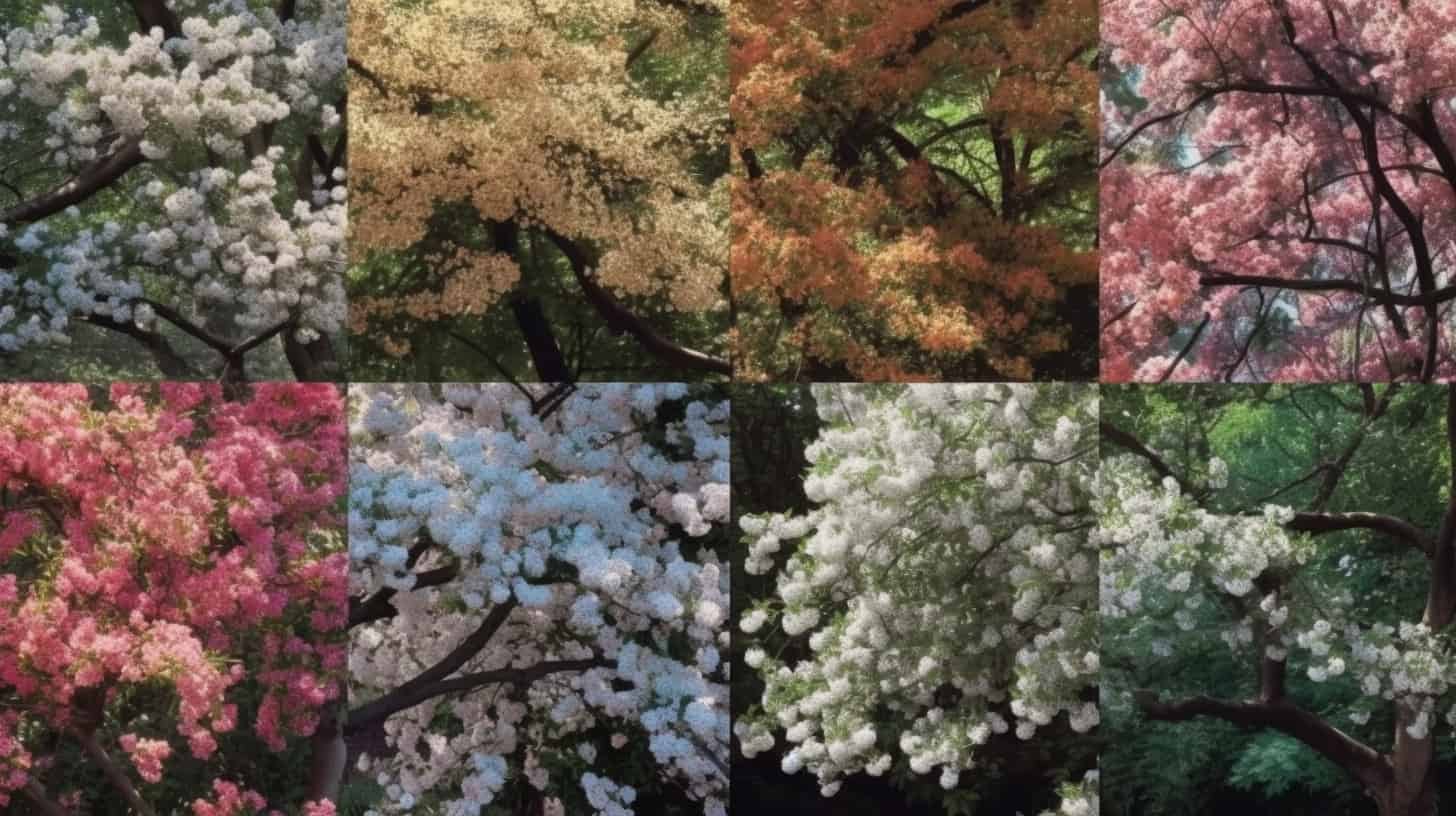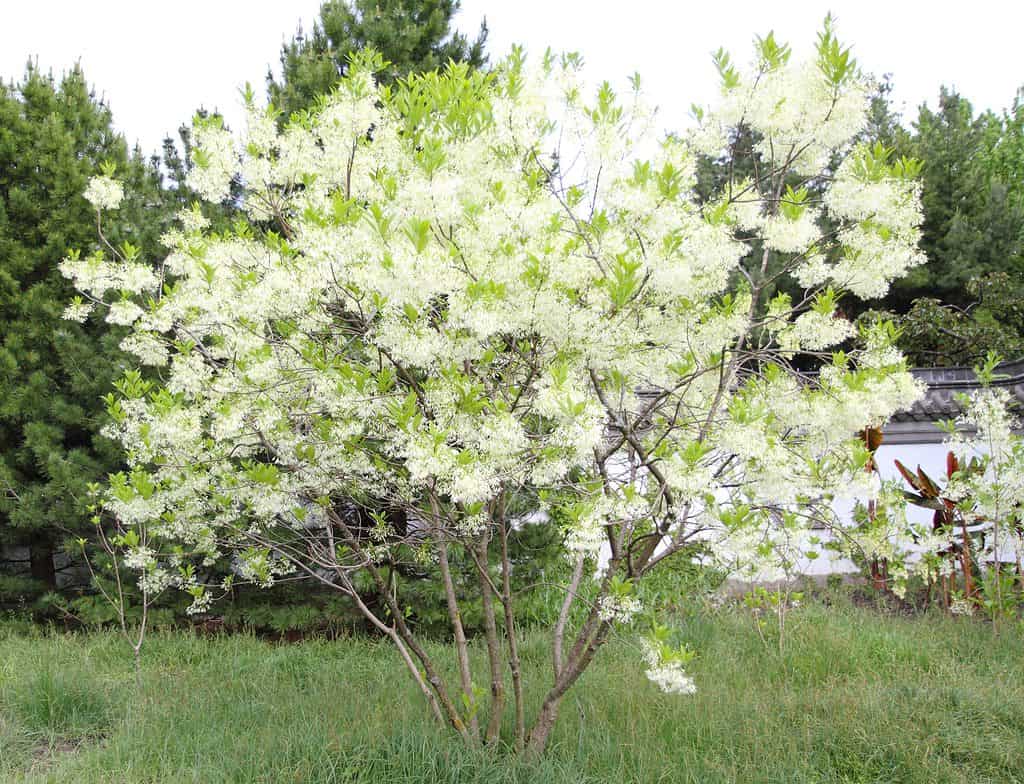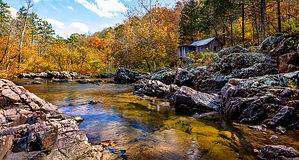If you’re looking to infuse your yard with charm, color, and a touch of elegance, small flowering trees are a great choice. While small in stature, their vibrant blossoms and delicate foliage pack a powerful punch that transforms your yard into a blossoming sanctuary. Whether you have a compact garden or a cozy backyard, these trees are the perfect choice to bring life, allure, and a touch of natural elegance to your landscape. Discover the 15 best small flowering trees to spruce up your outdoor space.
1. Carolina Cherry Laurel (Prunus caroliniana)

The fresh leaves of Carolina cherry laurel smell like maraschino cherries.
©Peter Turner Photography/Shutterstock.com
Native to the southeastern United States, Carolina cherry laurel brings elegance and privacy to gardens and yards. It is a versatile and attractive flowering tree that produces glossy, dark green leaves and clusters of fragrant white flowers in the early spring. Additionally, its blossoms attract native pollinators like hummingbirds, bees, and butterflies. Carolina cherry laurel grows densely, up to 30 feet tall, with a spread of around 25 feet.
The compact tree sports smooth, reddish-brown bark that contrasts against its dark foliage. It tolerates a range of soil types but prefers well-draining varieties. Specimens require consistent watering during their establishment. However, they are drought-tolerant and thrive in full sun to partial shade once established. Carolina cherry loyal is low-maintenance, though regular pruning helps maintain its shape and density. Plant specimens such as standalone ornamental trees, hedges, or privacy screens.
2. Carolina Silverbell (Halesia carolina)
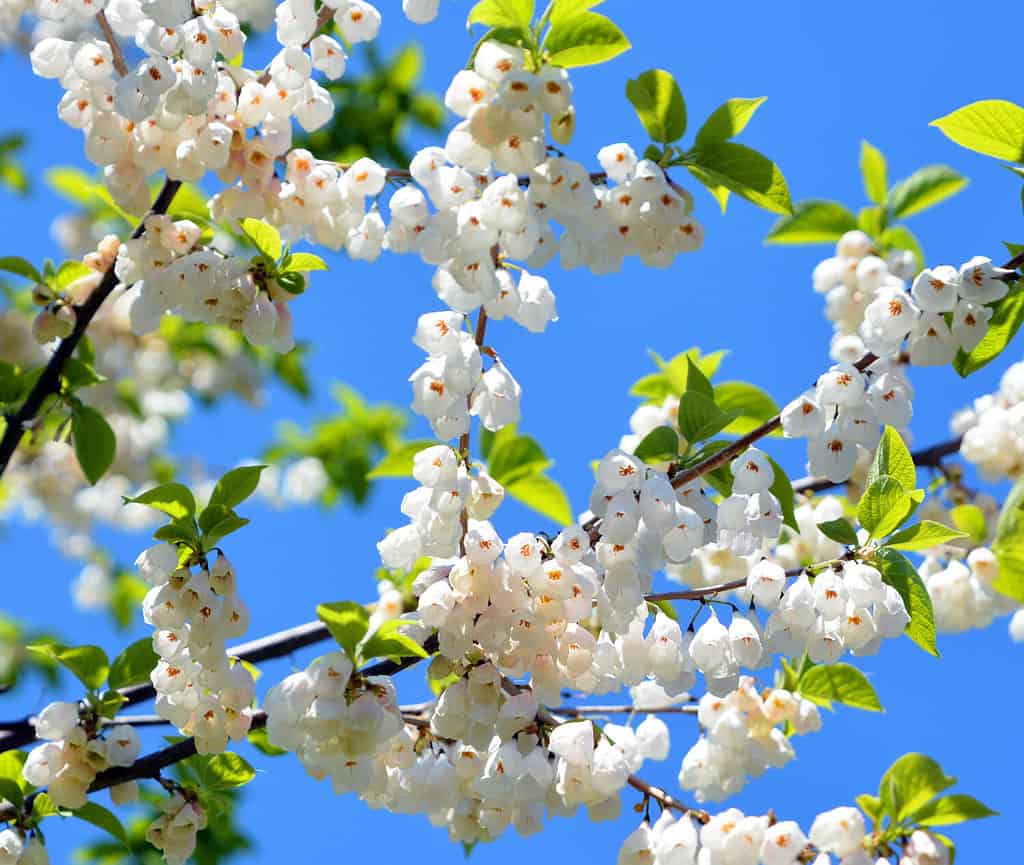
Silverbell is an evergreen tree that provides four seasons of interest.
©meunierd/Shutterstock.com
Carolina silverbell, also known as snowdrop tree or silverbell tree, is a charming and graceful flowering tree that is also native to the southeastern United States. It produces heart-shaped leaves that turn shades of vibrant yellow in the fall. Additionally, specimens produce clusters of pendulous, bell-shaped white flowers in every spring alongside its smooth, silver-gray bark. Carolina silverbell has layered branches with an open canopy, reaching up to 30 feet tall and 25 feet wide.
Specimens thrive in well-draining, acidic soils. However, they prefer moist conditions. Similarly, the small tree prefers partial shade during hot periods. Grow Caroline silverbell near patios, walkways, and woodland gardens. It is a low-maintenance variety that requires minimal pruning to maintain its natural shape. However, consistent moisture and adequate mulching is the key to success.
3. Crabapple (Malus spp.)
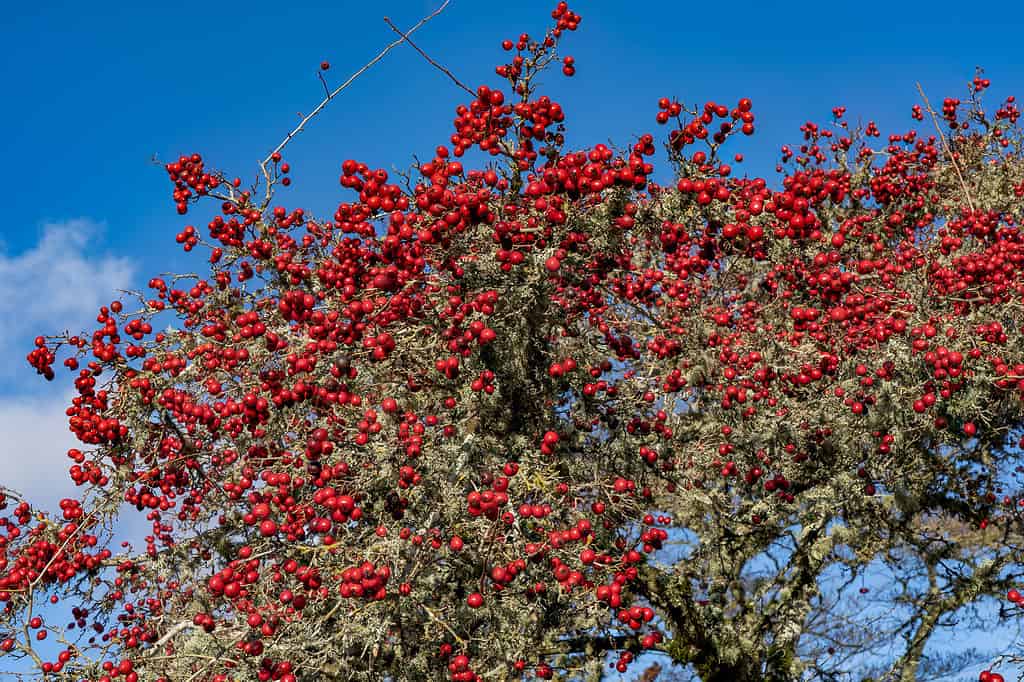
The fruits from crabapple trees are edible.
©Bob Pool/Shutterstock.com
Crabapple is a species of fruiting and flowering tree with high ornamental value. They are available in a variety of cultivars. Moreover, they produce textured bark, oval leaves, and spring blossoms that range from white and pink to deep red. However, the defining feature of crabapple trees is the small, colorful fruit that lasts through fall. Fruits change from red, orange, and yellow to burgundy, and the small fruiting trees grow up to 25 feet tall.
Crabapple prefers full sun to partial shade. However, full sun exposure produces the best blooms and fruit. It loves well-draining soils and regular watering. Crabapple makes a great focal point and specimen tree. Additionally, their dense growth pattern creates natural privacy screens. Varieties are easy to grow but benefit from regular pruning.
4. Crape Myrtle (Lagerstroemia spp.)

Crape myrtles arrived in the United States in 1790.
©Noel V. Baebler/Shutterstock.com
Crape myrtles are an adaptive choice with distinct bark and growth characteristics. They produce mottled barks in shades of brown, gray, and reddish-brown. Additionally, cultivars also produce elongated leaves that turn yellow, orange, and red in the fall. They bloom famous showy flower clusters that range in colors from white, pink, purple, and even red. Crape myrtles grow up to 30 feet with a multi-stemmed, twisting growth habit. Moreover, the flowering tree is available in dwarf varieties that only grow between 3 to 6 feet.
Crape myrtles require fertile, well-draining soil. They are drought-tolerant once established. However, they produce the best blooms when watered sufficiently. They grow best in full sun and serve as great focal points for yards and gardens. Additionally, specimens make great border trees and flowering privacy screens. Crape myrtles are low-maintenance, but regular pruning helps encourage robust blooms.
5. Dogwood (Cornus spp.)

Dogwood trees self-fertilize.
©Virunja/Shutterstock.com
Perhaps one of the most recognizable small flowering trees, the dogwood species encompasses various cultivars renowned for their beloved spring blooms and distinctive branching patterns. They grow up to 30 feet with a horizontal growth habit. Dogwood trees produce white or pink bursts of flowers in the spring alongside varying shapes and sizes of green foliage that turns red, purple, and burgundy in the fall.
Dogwood cultivars are easy to grow. However, they benefit from regular pruning to maintain their shape and improve their air circulation. Grow specimens in well-draining soil. However, ensure the soil has good water retention. These plants require regular watering during dry spells as well as full sun. Grow dogwood as a specimen tree near patios and in woodland gardens.
6. Dwarf Korean Lilac (Syringa meyeri)
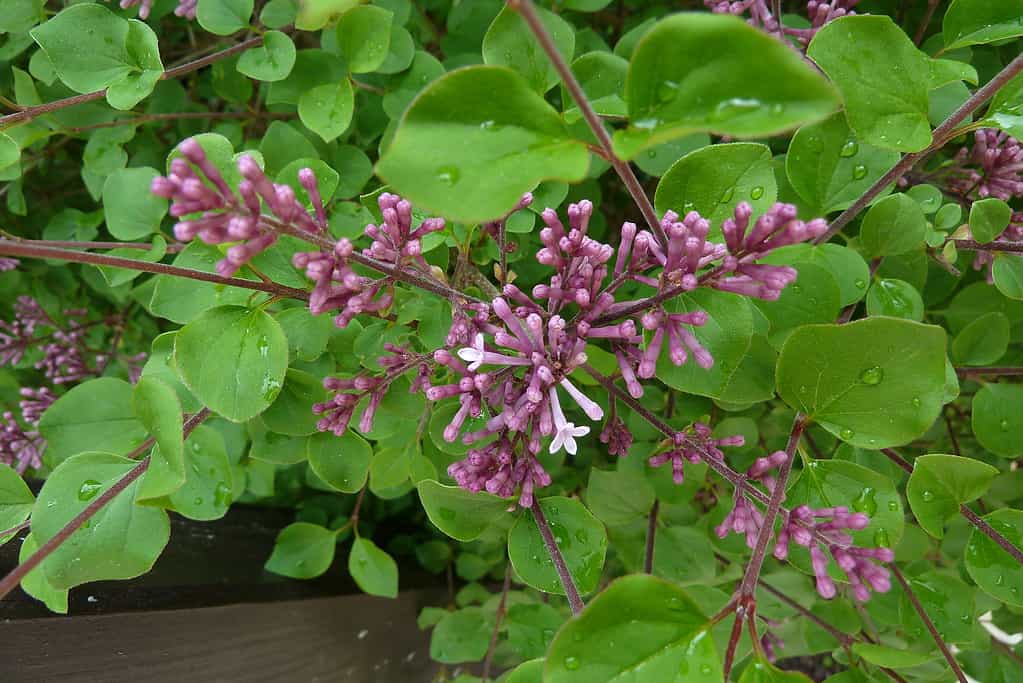
Dwarf Korean lilacs can re-bloom in the fall.
©Schnobby, CC BY-SA 3.0 , via Wikimedia Commons – Original / License
Charming and compact, dwarf Korean lilac adds elegance and fragrance to small landscapes. The highlight of this small flowering tree is abundant clusters of fragrant, pale lilac to lavender-pink blossoms that appear in the spring. Additionally, the flowers attract native pollinators. The compact specimen only grows to around 6 feet tall and wide with a rounded form and dense foliage for a tidy appearance.
Dwarf Korean lilacs love fertile, well-draining soil. However, specimens tolerate a range of soils and require regular watering during the establishment phase. Moreover, they are quite drought-tolerant once established. They thrive in full sun to light shade. However, full sun conditions produce the most vibrant blooms. Grow the low-maintenance tree in areas with limited space, including patios and courtyards.
7. Eastern Red Cedar (Juniperus virginiana)
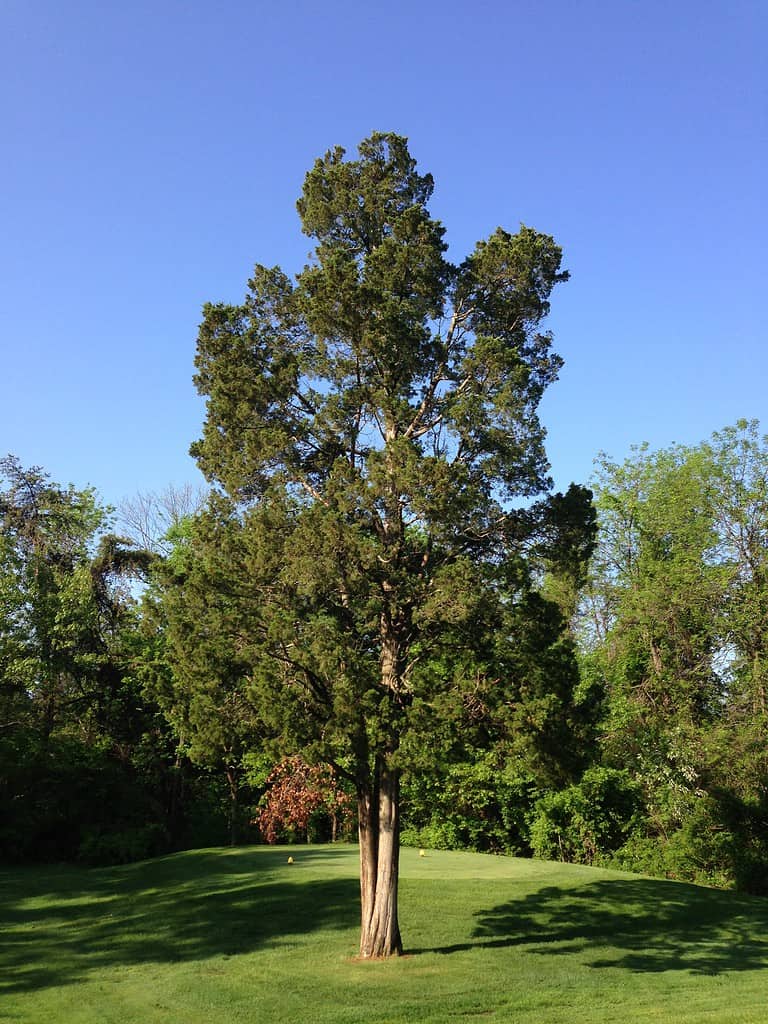
The wood of Eastern red cedar was once used to make pencils.
Native to North America, the hardy evergreen tree, eastern red cedar, sports scaled, blue-green foliage that retains its color year-round. Females also produce small round berries that invite songbirds and other wildlife to your landscape. The conical tree grows around 40 feet tall and is only 10 to 20 feet wide.
Eastern red cedar is low-maintenance and requires minimal pruning. Similarly, it is pest- and disease-resistant as well as drought-tolerant once established. It thrives in most soil types, including well-draining, sandy, and rocky soils. Grow eastern red cedar in full sun. Additionally, specimens make great windbreaks, privacy screens, and accent trees for naturalized landscapes.
8. Eastern Redbud (Cercis canadensis)
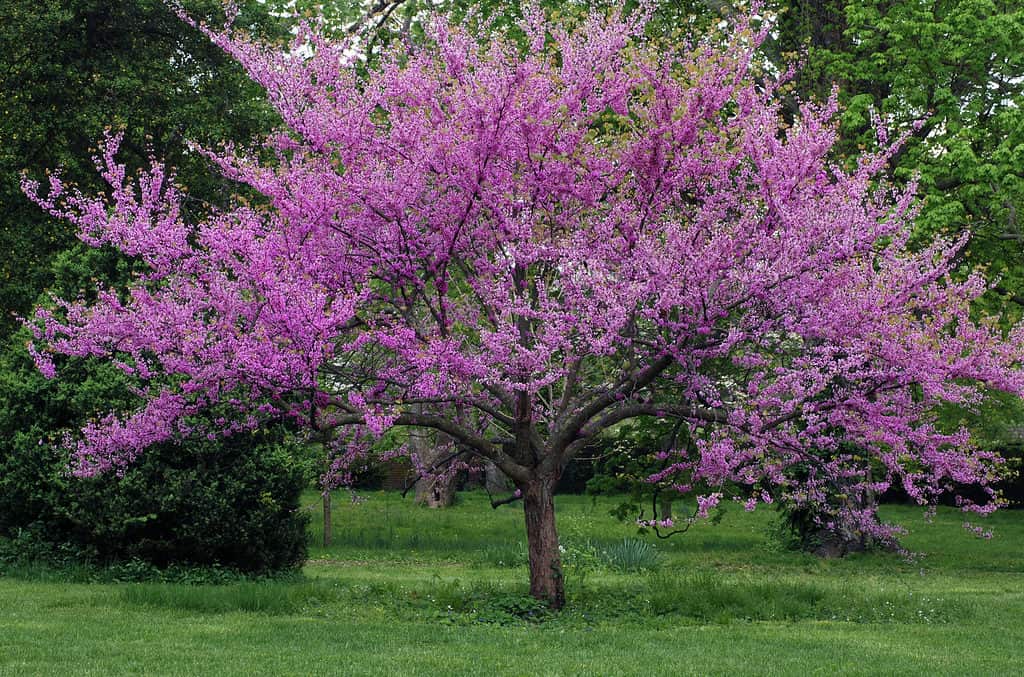
Several parts of Eastern redbud are edible.
©Marie C Fields/Shutterstock.com
Another North American native small flowering tree, eastern redbud, steals the show in the spring. It produces a profusion of rose-pink to purple blooms that emerge directly from its branches and trunk. Additionally, heart-shaped leaves follow the blossoms, turning yellow in the fall. Eastern redbud grows up to 30 feet. Also, like crape myrtle, it has a multi-stemmed growth habit. However, specimens sport a rounded crown that creates an elegant silhouette.
Eastern redbud is easy to grow and requires minimal maintenance. Of course, pruning helps keep its neat and tidy shape. Specimens are resistant to pests and diseases and prefer well-draining soils. Most importantly, eastern redbud requires regular watering, especially during dry spells. It thrives in full sun but appreciates light shade in hot climates. Grow eastern redbud as an accent tree near patios and in mixed shrub borders.
9. Elderberry (Sambucus spp.)
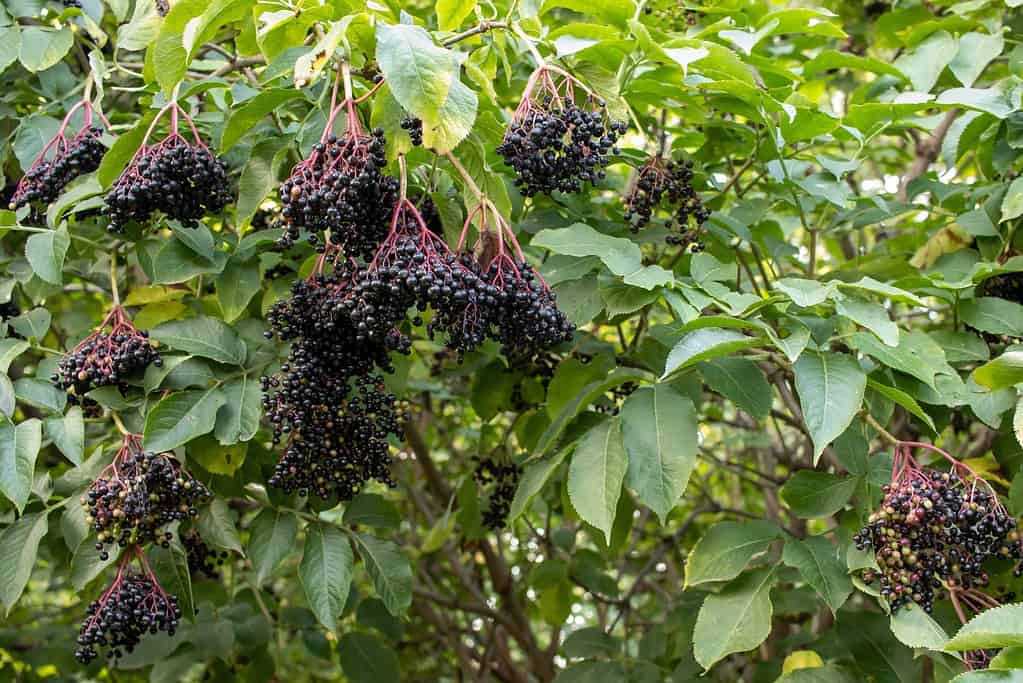
Unripened elderberries are poisonous, but ripe elderberries are edible.
©Juver/Shutterstock.com
Elderberries encompass various cultivars of small flowering trees, and garden enthusiasts treasure them for their delicate flowers. They produce lush, pinnate leaves alongside clusters of small, fragrant white flowers in the spring. Additionally, specimens produce clusters of berries that ripen in late summer to early fall. More importantly, the berries serve as more than an ornamental backdrop. They are also edible and often used to make jams, jellies, and herbal remedies.
Elderberries grow to 12 feet tall and prefer well-draining soil. However, the soil needs good moisture retention as elderberries require regular watering. They love full sun and are relatively easy to grow. They require minimal maintenance. However, they attract many pests, including aphids. Grow elderberries in hedgerows, mixed borders, and naturalized areas to invite beneficial pollinators to your yard and garden.
10. Flowering Almond (Prunus glandulosa)
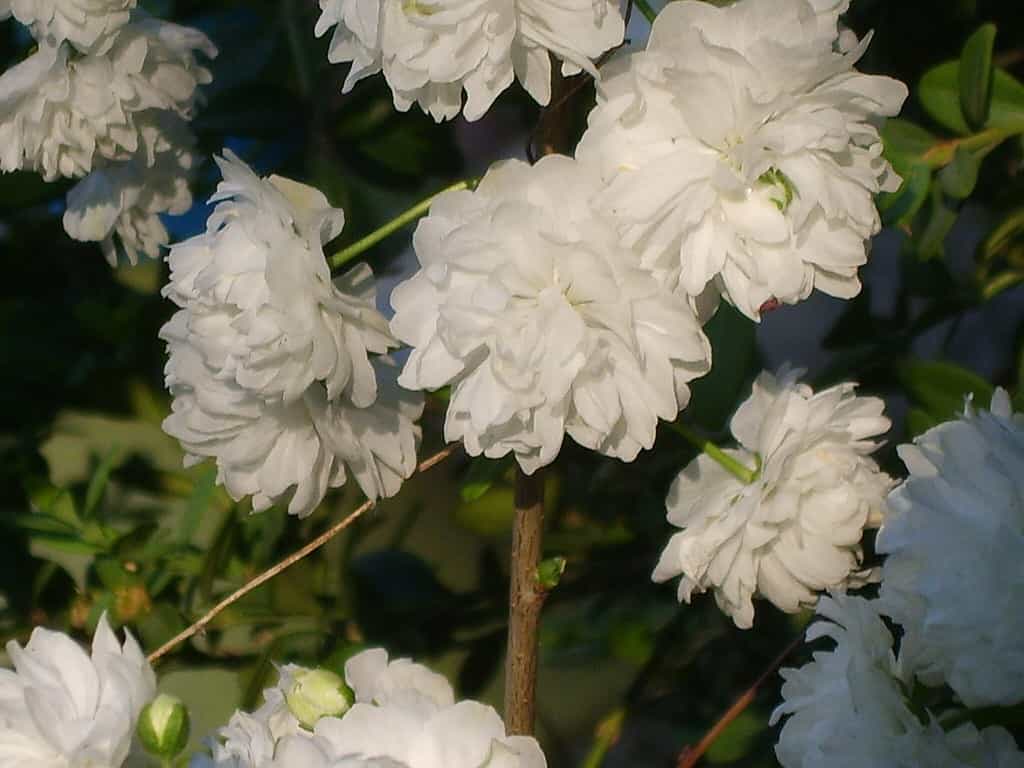
Almond flowers are botanically related to roses.
©Dalgial, CC BY-SA 4.0 , via Wikimedia Commons – Original / License
A flowering almond is a small tree or large shrub that produces bursts of spring color. The compact specimen blooms clusters of charming pink or white blossoms that resemble miniature roses in the early spring, followed by green foliage that turns yellow in the fall. Flowering almond only grows up to 5 feet tall, making it a great addition to small spaces.
It is easy to grow but requires some maintenance. Pruning helps specimens maintain their shape and encourages new growth. Flowering almond is disease- and pest-resistant and grows best in well-draining soils and full sun or partial shade. However, like most flowering trees, specimens produce the best blooms when grown in full sun. Lastly, the ornamental tree requires regular watering. Grow flowering almonds in small spaces, borders, and rock gardens.
11. Flowering Dogwood (Cornus florida)

Flowering dogwood is the state tree of Virginia and Missouri.
©iStock.com/JillLang
The flowering dogwood is an iconic small flowering tree native to eastern North America. It produces elegant pink or white bracts that surround true flowers. Moreover, these bracts give the appearance of large, petal-like blooms. Flowering dogwood’s foliage is oval and turns shades of red in the fall. Specimens reach up to 30 feet and have a horizontal branching habit.
Flowering dogwood loves well-draining, fertile soil. More importantly, it requires regular watering and partial shade to protect it from harsh afternoon sun. It is a high-maintenance cultivar and requires regular pruning. Similarly, flowering dogwood requires a watchful eye and is not pest- or disease-resistant. Grow flowering dogwood as an accent tree near patios or in woodland gardens.
12. Franklin Tree (Franklinia alatamaha)
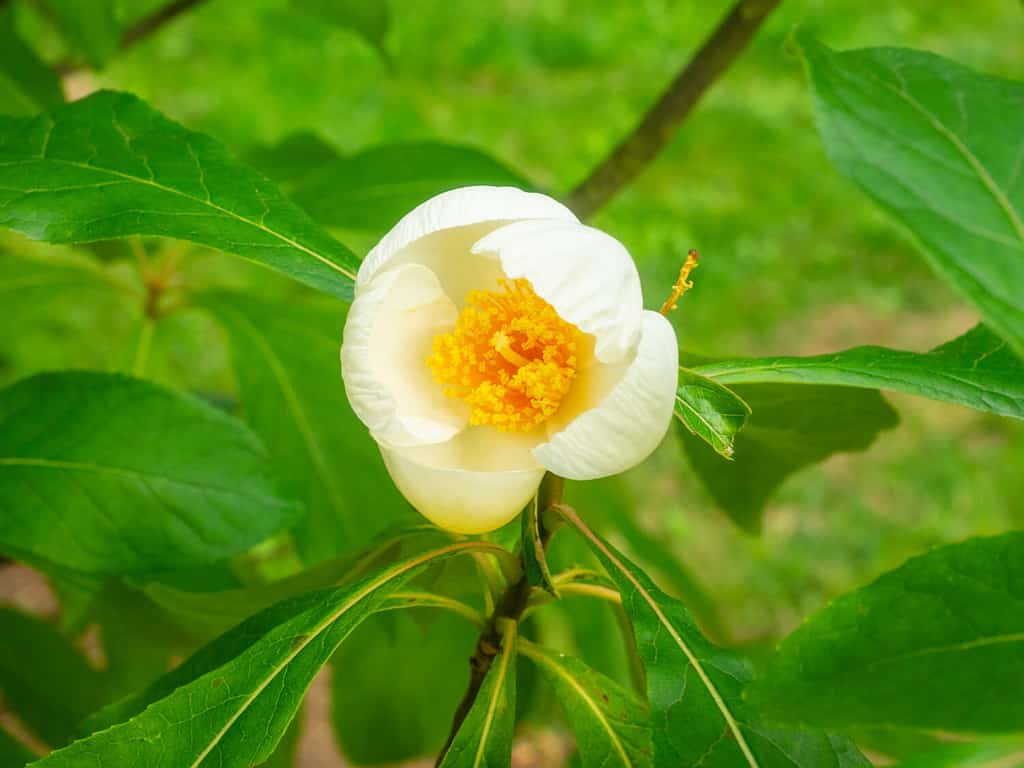
The Franklin tree is extinct in the wild.
©Mariusz S. Jurgielewicz/Shutterstock.com
Rare and captivating, the Franklin tree has a unique history. Its smooth and gray bark contrasts with its dark green, serrated foliage. It also produces large, fragrant white flowers with showy yellow centers in the late summer to early fall. The late bloomer grows up to 20 feet tall with a pyramidal growth habit.
The Franklin tree, named after Benjamin Franklin, was discovered in Georgia in the 18th century. Experts believe it is extinct in the wild, making cultivated specimens valuable. The expensive tree is extremely high-maintenance. However, with proper care, they thrive in well-draining, fertile soils. Plant franklin trees as focal points, mixed borders, or standalone specimens.
13. Fringe Tree (Chionanthus spp.)
The fringe tree is a species of small flowering tree with delicate blooms. They are native to North America and produce cascading, leathery, fringe-like flowers in the spring. Generally, blossoms are white or cream-colored and attract pollinators. Fringe trees reach 20 feet tall and have rounded or vase-shaped growth habits.
Specimens prefer well-draining soil but tolerate a range of soil types. In contrast, they require regular watering and thrive in full sun to partial shade. Plant fringe trees as specimen trees or mixed shrub borders. They are low-maintenance. However, they require some pruning but are resistant to pests and diseases.
14. Golden Chain Tree (Laburnum spp.)
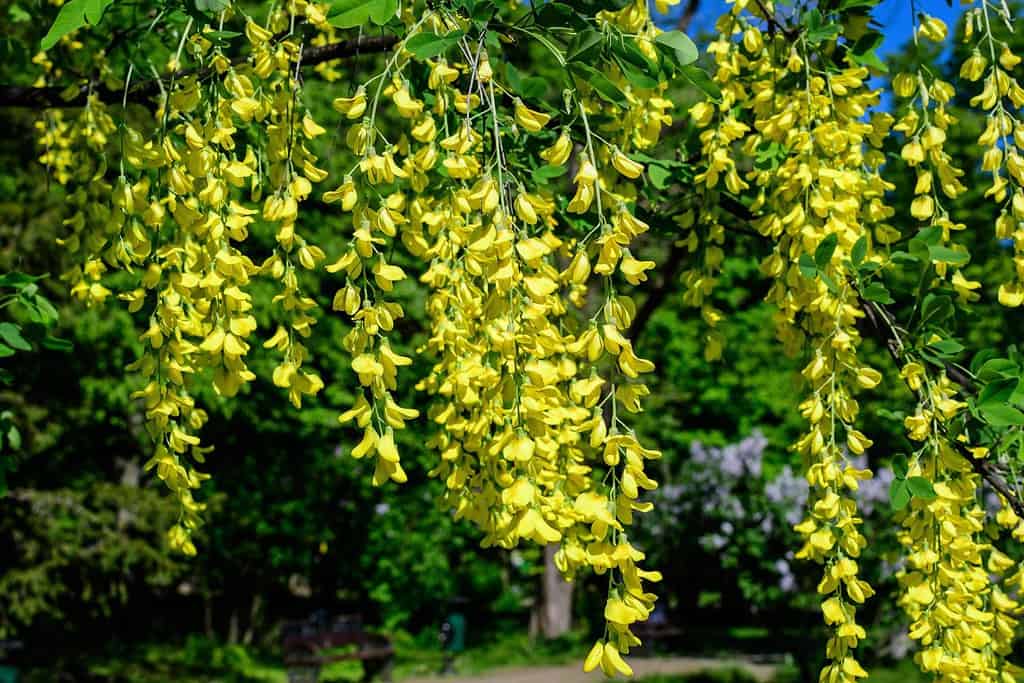
Golden chain trees are a member of the pea family.
©Cristina Ionescu/Shutterstock.com
The golden chain tree is a captivating ornamental specimen known for its unique blooms. It produces pendulous chains of vibrant yellow flowers in the spring. Also, its stunning blooms attract native pollinators. Specimens reach up to 25 feet tall and wide and feature a rounded canopy.
Golden chain trees require minimal pruning. However, they require regular watering. More importantly, all parts of the tree are toxic to humans and animals. Golden chain trees thrive in full sun and well-draining soils with good fertility. Plant the vibrant yellow trees in small gardens, patios, and as focal specimens.
15. Hawthorn (Crataegus spp.)

Hawthorn trees are members of the rose family.
©Vika Malina/Shutterstock.com
Another species of berry-producing flowering tree, the hawthorn, provides aesthetic appeal, ecological benefits, and a touch of folklore. Specimens grow up to 25 feet with rounded or irregular canopies and thorny branches. They produce spring clusters of white, pink, or red flowers. Similarly, small, colorful berries follow the spring blossoms, inviting birds and other small mammals.
Hawthorn trees require regular watering during establishment. However, after they are established, they are drought-tolerant. They love full sun and well-draining, fertile soils. Hawthorns are easy to grow but require some maintenance. Regular pruning helps shape the tree and improve air circulation. Grow these unique specimens as informal hedges, mixed borders, or standalone accent trees.
16. Japanese Flowering Apricot (Prunus mume)
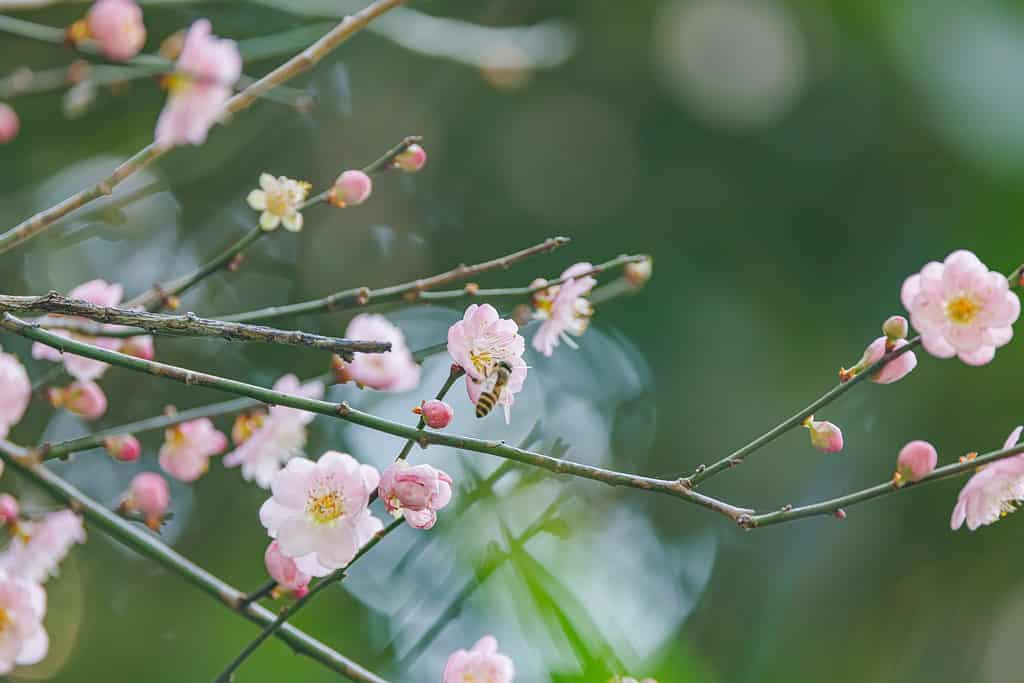
The Japanese flowering apricot is one of the longest-lived flowering trees.
Early-blooming Japanese flowering apricots signal the arrival of spring. They produce pink or white blossoms in the late winter to early spring before their leaves emerge. The flowers emit a delicate fragrance that adds charm to the small flowering tree. Additionally, Japanese flowering apricot produces ovate, deep green leaves, and smooth, grayish-brown bark.
Specimens reach up to 20 feet with a spreading growth habit and rounded canopy. They require minimal maintenance, but regular pruning helps maintain their shape and encourages fresh growth. Importantly, Japanese flowering apricots are susceptible to disease. They love well-draining soils and full sun. Specimens are also relatively drought-tolerant. Grow Japanese flowering apricots near patios and entryways.
17. Japanese Flowering Cherry (Prunus serrulata)

Japanese flowering cherry grows naturally in Japan, China, and Korea.
©Marie Shark/Shutterstock.com
The Japanese flowering cherry, or Oriental cherry and sakura tree, symbolizes beauty, elegance, and fleeting moments in Japanese culture. The iconic variety produces serrated, dark green leaves that turn shades of bronze in the fall. Additionally, it produces delicate and iconic pink and white blossoms in early spring amongst a backdrop of reddish-brown bark. Japanese flowering cherries have a rounded canopy and arching branches. Moreover, the fragrant trees reach heights of up to 25 feet.
Japanese flowering cherries make an excellent focal point for any garden. They thrive in well-draining, fertile soils. However, they require regular watering, especially during times of drought. They grow best in full sun to partial shade. However, full sun conditions produce the most blossoms. Unfortunately, Japanese flowering cherries are high-maintenance and require regular pruning to maintain their shape. They are susceptible to disease and short-lived. What’s more, Japanese cherries only live around 15 to 20 years.
18. Japanese Maple (Acer palmatum)

Japanese maples can get sunburns.
©iStock.com/Michel VIARD
Japanese maple is another ornate tree sporting intricate branching patterns, providing architectural beauty to landscapes. It produces standout, intricately lobed leaves that come in a range of colors, including red, green, purple, and variegated combinations. Additionally, foliage evolves with the changing seasons. Japanese maple also produces small flowers in the spring that add a subtle beauty to its appearance.
Japanese maple prefers well-draining soil with good moisture retention. Most importantly, it requires regular watering and partial shade. Specimens have interesting textures and patterns on their bark, and mature trees develop a shiny patina. They grow up to 25 feet with a mounding growth habit. Japanese maple is high-maintenance and requires pruning to maintain its shape. Plant the ornamental tree in garden beds or as standalone specimens.
19. Japanese Snowbell (Styrax japonicus)
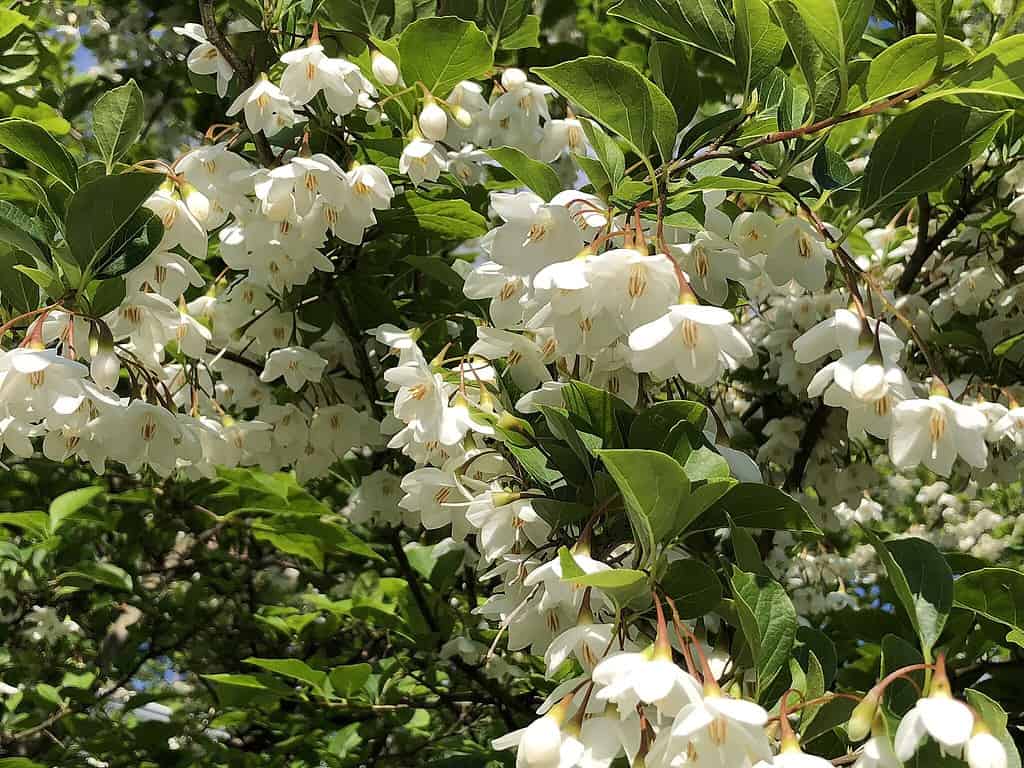
The seeds of Japanese snowbells were once used to make insecticides.
©Famartin, CC BY-SA 4.0 , via Wikimedia Commons – Original / License
Another small flowering tree with pendulous blooms, the Japanese snowbell, adds a touch of grace and beauty to gardens and landscapes. It produces cascading, bell-shaped white flowers that dangle from its branches in late spring to early summer. The fragrant blossoms accompany glossy, oval leaves with a deep green color. Additionally, the Japanese snowbell features smooth gray bark that creates a streaking contrast between its foliage and flowers.
The graceful tree reaches up to 30 feet and has a rounded and spreading growth habit. It is low-maintenance and does not require heavy pruning. However, specimens do require regular watering and mulch. They are disease- and pest-resistant and grow best in well-draining, fertile soils. Grow Japanese snowbells in partial shade as a focal point in your yard or garden.
20. Magnolia (Magnolia spp.)
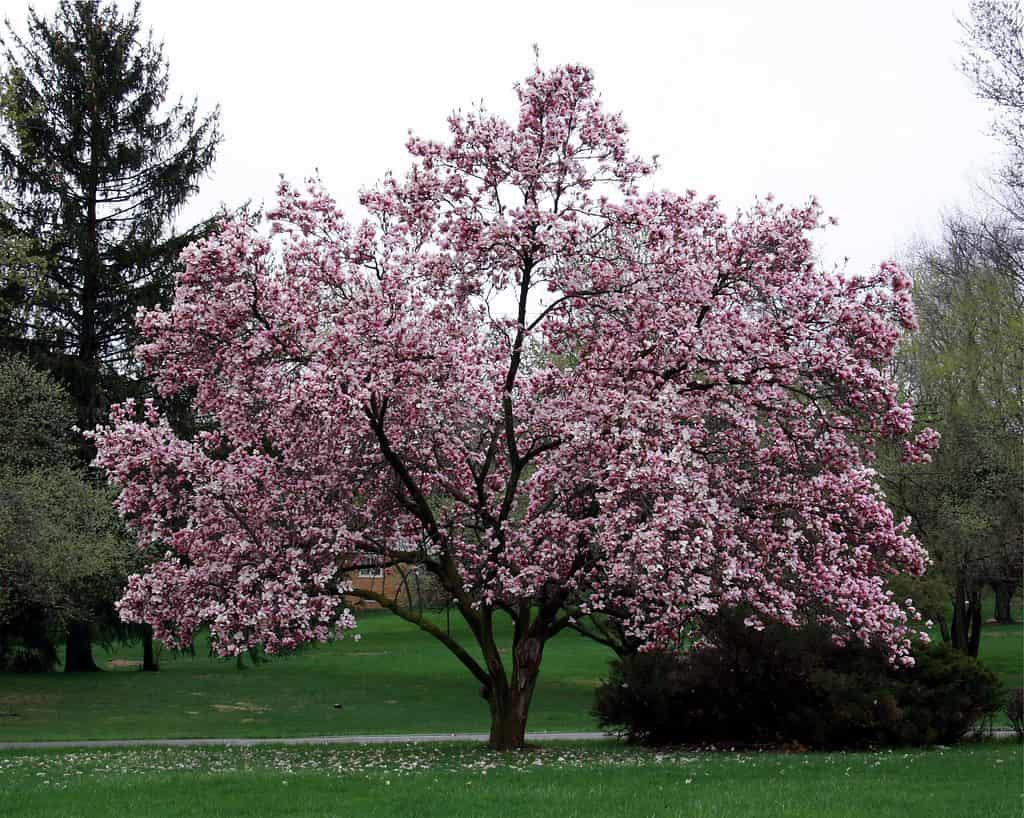
Magnolia fossils date back over 100 million years.
©shootz photography/Shutterstock.com
Magnolia is another species of small flowering tree renowned for its show-stopping flowers. They produce smooth, silvery bark and large, fragrant blooms in shades of white, pink, or purple. Additionally, specimens produce glossy leaves that create an attractive backdrop for their blossoms. They vary in size but only reach up to 30 feet. They also have various growth habits, including pyramidal, spreading, and multi-stemmed.
Magnolias grow best in well-draining, fertile soil and full sun to partial shade. They are relatively low-maintenance but require regular watering and occasional pruning. Plant these elegant specimens as focal points, along driveways, or in mixed borders.
21. Red Buckeye (Aesculus pavia)
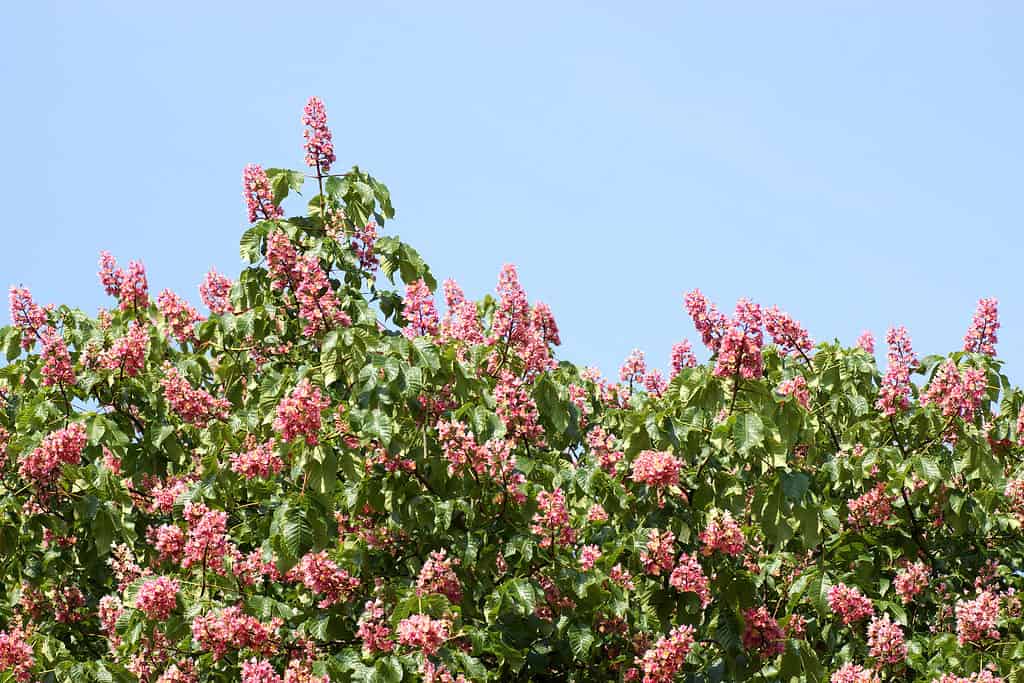
The blooms of red buckeye resemble firecrackers.
©Bildagentur Zoonar GmbH/Shutterstock.com
Native to North America, red buckeye provides many ecological benefits. Specimens have smooth, gray bark that contrasts with their dark green, palmate leaves. What’s more, they produce spikes of tubular red or orange flowers in the spring that attract native pollinators. Similarly, they also produce capsule-like fruits containing shiny, dark brown seeds, a valuable food source for local wildlife.
Red buckeye is low-maintenance and does not require heavy pruning. However, they require regular watering and prefer well-draining, fertile soils. It’s worth noting they are drought-tolerant once established and reach up to 20 feet with a rounded growth habit. Grow red buckeye in naturalized areas, woodland gardens, and as focal points near patios.
22. Serviceberry (Amelanchier spp.)

Serviceberry fruits are edible.
©Wirestock/iStock via Getty Images
Another species of flowering tree, serviceberry, combines ornamental beauty, wildlife value, and culinary potential. They produce serrated leaves alongside smooth, gray bark. They also produce clusters of white or pink flowers that resemble apple blossoms. Similarly, they produce berries that transition from green to red, purple, or blue-black. The berries are edible and often used in jams and pies.
Serviceberry grows up to 25 feet with a spreading growth habit. They require minimal maintenance, but pruning helps them retain their rounded shapes. Grow serviceberry as focal points, in mixed borders, or as understory plants. They love well-draining soil with good moisture retention and thrive in full sun to partial shade.
23. Smoke Tree (Cotinus spp.)
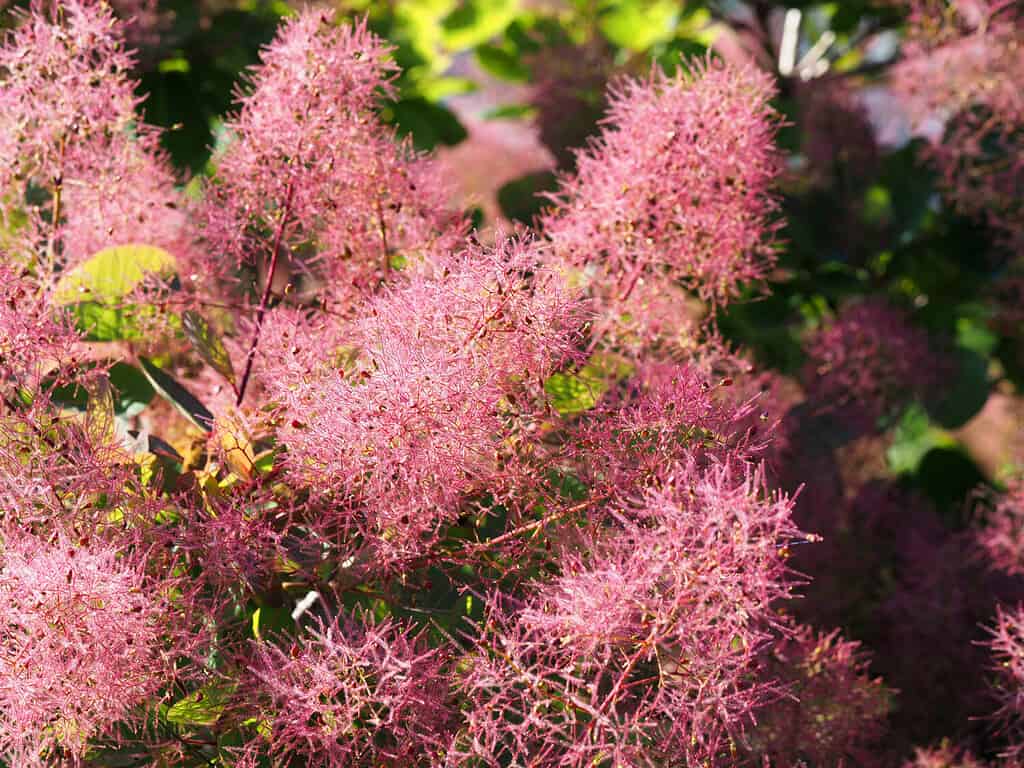
Billowy hairs attach to the flower clusters of smoke trees.
©ANGHI/Shutterstock.com
The smoke tree species encompasses various cultivars of small flowering trees that resemble billowing smoke. The unique specimens produce feathery panicles of tiny flowers that emerge in early summer. Another key point is that flowers transition from pink to smoky-pink or purplish hues as they mature. Smoke trees reach up to 20 feet and have a multi-stemmed growth habit, creating a unique and sculptural appearance.
The low-maintenance specimens do not require heavy pruning. However, it is important to note that regular pruning promotes healthy growth. They grow best in well-draining soil with good moisture retention and require regular water during establishment. Moreover, they are drought-tolerant once established and grow best in full sun to light shade. Plant smoke trees as focal points, in mixed borders, or as specimen plants.
24. Sourwood (Oxydendrum arboreum)
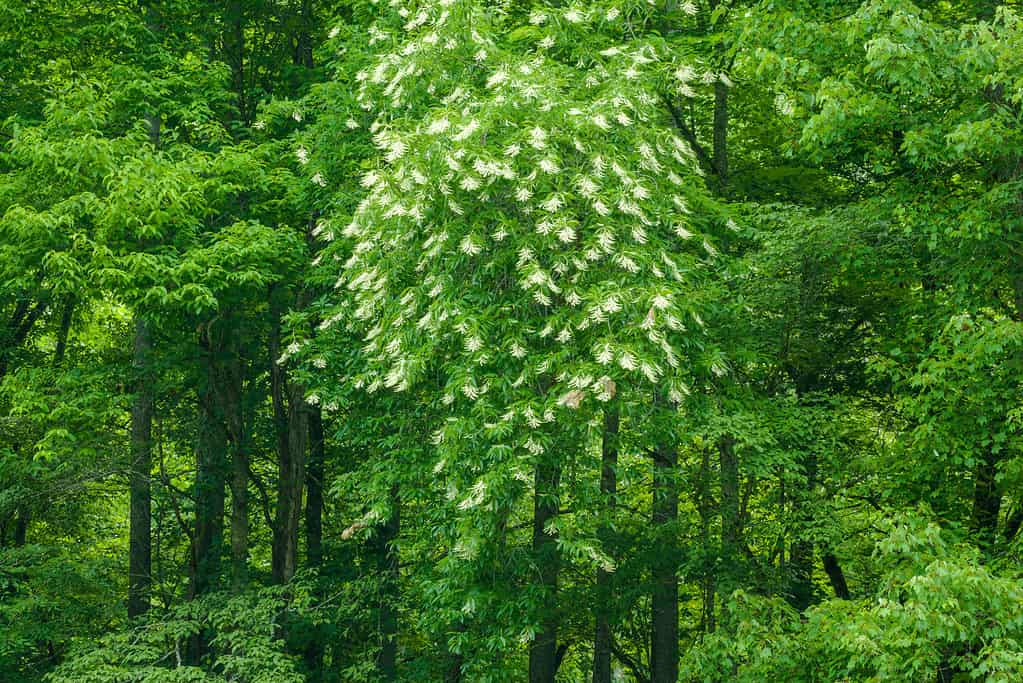
Sourwood honey is common in the South.
©Jerry Whaley/Shutterstock.com
Sourwood is another native flowering tree with delicate blooms. It produces attractive, glossy, long leaves that turn brilliant shades of red, orange, or purple in the fall. In the summer, it produces drooping clusters of white, urn-shaped flowers that attract pollinators. Sourwood’s bark starts out smooth and gray but develops a striking pattern of ridges and furrows as it matures.
The elegant flowering tree is low-maintenance. As such, they do not require heavy pruning. However, regular inspection for pests and diseases is necessary. Specimens reach up to 35 feet and have a pyramidal growth habit. They grow best in well-draining soil and require regular watering. Grow sourwood in naturalized areas, woodland gardens, and as specimen trees.
25. Witch Hazel (Hamamelis spp.)
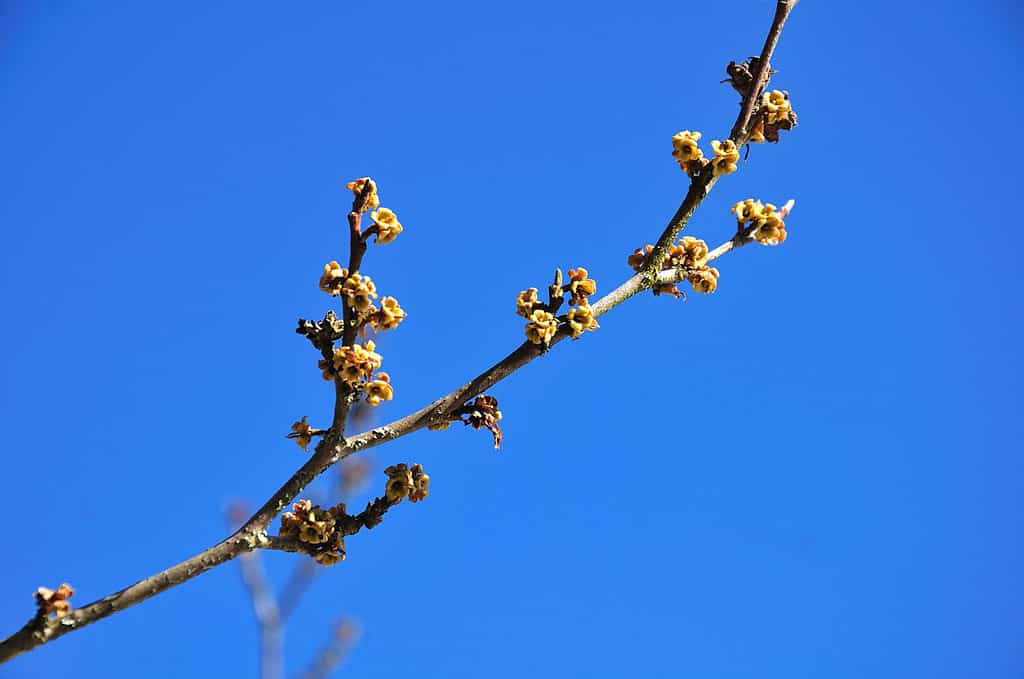
Witch hazel has medicinal uses.
©Carmen Hauser/Shutterstock.com
Witch hazel is a species of flowering tree with early spring blooms. They produce varying foliage shapes and fragrant, spider-like flowers that appear in late winter to early spring before leaves emerge. Additionally, its foliage adds fall appeal, with leaves transitioning to vibrant shades of yellow, orange, or red. Witch hazel grows up to 20 feet with a spreading growth habit.
The unique specimens thrive in well-draining soils with good moisture retention and require regular watering until established. They are relatively drought-tolerant and low-maintenance. Unfortunately, they are not disease- or pest-resistant. Plant witch hazel near entryways and mixed borders.
Summary: 25 Best Small Flowering Trees
| Number | Common Name | Mature Height Range |
|---|---|---|
| 1 | Carolina Cherry Laurel | 10 to 20 feet |
| 2 | Carolina Silverbell | 20 to 40 feet |
| 3 | Cherry Blossom | 15 to 40 feet |
| 4 | Crabapple | 10 to 30 feet |
| 5 | Crape Myrtle | 6 to 30 feet |
| 6 | Dogwood | 15 to 40 feet |
| 7 | Dwarf Korean Lilac | 4 to 6 feet |
| 8 | Eastern Red Cedar | 30 to 40 feet |
| 9 | Eastern Redbud | 20 to 30 feet |
| 10 | Elderberry | 5 to 12 feet |
| 11 | Flowering Almond | 3 to 6 feet |
| 12 | Flowering Dogwood | 15 to 40 feet |
| 13 | Franklin Tree | 20 to 30 feet |
| 14 | Fringe Tree | 12 to 20 feet |
| 15 | Golden Chain Tree | 15 to 25 feet |
| 16 | Hawthorn | 15 to 30 feet |
| 17 | Japanese Flowering Apricot | 15 to 25 feet |
| 18 | Japanese Maple | 6 to 25 feet |
| 19 | Japanese Snowbell | 15 to 25 feet |
| 20 | Magnolia | 15 to 40 feet |
| 21 | Red Buckeye | 10 to 20 feet |
| 22 | Serviceberry | 5 to 20 feet |
| 23 | Smoke Tree | 10 to 15 feet |
| 24 | Sourwood | 20 to 30 feet |
| 25 | Witch Hazel | 10 to 20 feet |
Thank you for reading! Have some feedback for us? Contact the AZ Animals editorial team.

